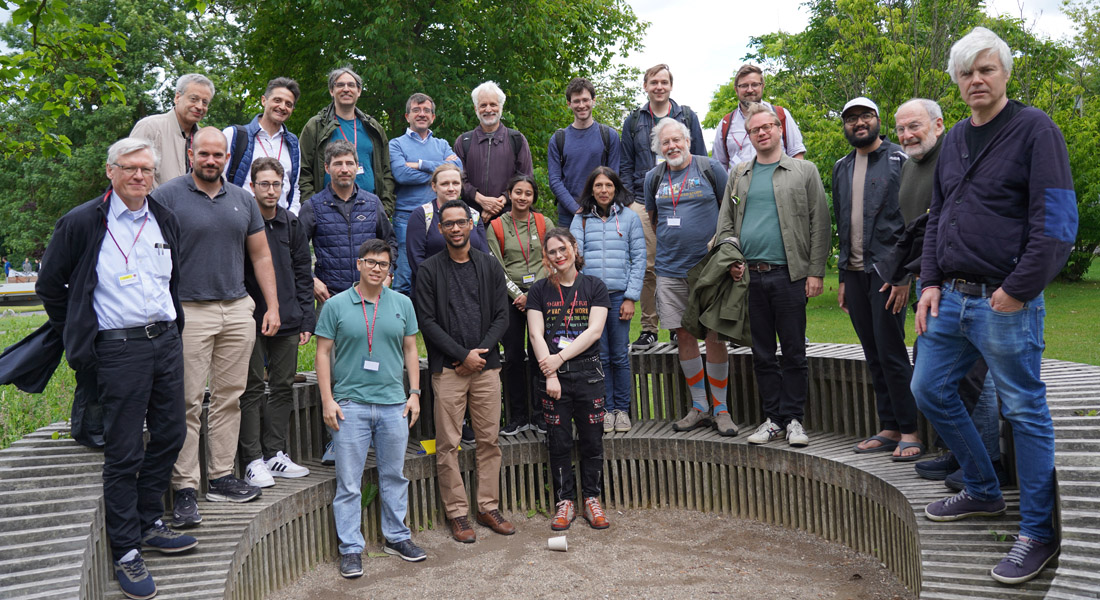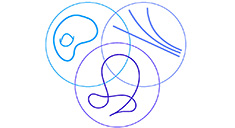Copenhagen Geometry Conference 2024
University of Copenhagen, 10-14 June 2024
Press the picture or here for a bigger picture
The purpose of this conference is to bring together several international experts on geometry and geometric analysis, including in topics such as mean curvature flow, singularity analysis in flows, minimal surfaces, constant mean curvature surfaces and geometric partial differential equations.
- David Hoffman (Stanford)
- Nikolaos Kapouleas (Brown)
- Robert Kusner (Amherst)
- Jason Lotay (Oxford)
- Joaquín Pérez (Granada)
- Antonio Ros (Granada)
- Natasa Sesum (Rutgers)
- Brian White (Stanford)
(GPS f/ Madklubben: 55.703952453868816, 12.57727016944879)
All auditoria above are situated at the H.C. Ørsted Institute, Universitetsparken 5, DK-2100 Copenhagen.
Auditoriums 3, 5 & 6 are found below ground level just off the main hall, Auditorium 10 is up the stairs in front of the MATH library.
Here’s a Google Maps pin & GPS coordinates directly to the MATH building:
https://maps.app.goo.gl/vXCKzHp7edQ5HzJd9
GPS: 55°42'02.2"N 12°33'38.7"E
An entrance door is found on the northwest side of the MATH building, which faces into the campus park in the direction of the August Krogh Building/Zoology Museum - you can get straight to Auditorium 3, where the first talk on Monday will take place, by simply continuing southeast through the main hall from this entry door). On your way along that route, you will run right into registration & coffee☕!
- The exact room location of e.g. “Aud 3” can be seen here:
https://maps.app.goo.gl/NLgqTpbUwPs5GiFn6
Lunch [*]:
Books of abstracts to be posted here as a .pdf later: TitlesAbstracts-CGC2024.pdf
Speaker: Antonio Ros
Title: Minimal immersions of small genus surfaces by first eigenfunctions
Abstract: The first normalized eigenvalue of the Laplacian is a functional defined on the moduli space of closed Riemannian surfaces. For a given genus, critical points of the functional, in particular the maximum ones, and their relations with conformal geometry and minimal surfaces of the sphere is a natural and interesting field of research. In our talk we will discuss these issues, focusing on small genus surfaces. We revisit the genus 2 Bolza Riemann surface and we present the cases of genus 3 Klein and Fermat's quartic curves.
Speaker: Jason Lotay
Title: Joyce conjectures for Lagrangian mean curvature flow with circle symmetry
Abstract: Special Lagrangian submanifolds are distinguished Lagrangian submanifolds in Calabi-Yau manifolds (that are Ricci-flat and Kaehler) which are volume minimizing in their homology class. Given this property, it is natural to expect that one might be able to decompose a Lagrangian in a Calabi-Yau manifold into special Lagrangians. Joyce made a series of conjectures for how to produce such a decomposition via Lagrangian mean curvature flow. I will describe work with G. Oliveira which verifies aspects of Joyce’s conjectures in the setting of Lagrangian surfaces in gravitational instantons with circle symmetry.
Speaker: David Hoffman
Title: Annuloids and ∆-Wings
Abstract: Paco Martín, Brian White and I have found new annular examples of complete translating solitons for the mean curvature flow. The lecture will describe these surfaces and indicate how they are related to a family of translating graphs, the ∆-wings.
Speaker: Natasa Sesum
Title: Instability of peanut solutions
Abstract: Hamilton predicted the existence of mean curvature flow solutions that extinct to a point in finite time T, but never become convex before time T. They are called peanut solutions and their existence and asymptotics were given in the paper by Angenent and Velazquez. For any of those we show that in any neighborhood of it there exists an initial data whose MCF develops spherical singularity, and also an initial data whose MCF develops nondegenerate neckpinch. We also show that for any sequence of perturbations of the peanut solution, all of which develop a spherical singularity, after appropriate rescaling, the sequence converges to the Ancient oval solution. This is a joint work with Angenent and Daskalopoulos.
Speaker: Brian White
Title: Fattening in Mean Curvature Flow
Abstract: We will discuss a family of closed embedded surfaces that fatten under mean curvature flow. (Joint work with Tom Ilmanen.)
Speaker: Joaquín Pérez
Title: Hierarchical clustering of blow-up limits in sequences of CMC surfaces with bounded Morse index
Abstract: (Joint work with William H. Meeks III)
Given ε > 0, I ∈ N ∪ {0} and K0, H0 ≥ 0, let X be a complete Riemannian 3-manifold with injectivity radius Inj(X) ≥ ε and with the supremum of absolute sectional curvature at most K0, and let {Mn}n be a sequence of complete immersed surfaces in X of constant mean curvature Hn ∈ [0, H0] with Morse index at most I. We will describe how the interesting ambient geometry of the immersions is organized locally around at most I points where the norm of the second fundamental form takes on large local maximum values, and where the local pictures on different blowing-up scales are complete immersed minimal surfaces in R3 with index at most I and finitely many branch points. The novelty of our analysis consists of understanding clustering phenomena, i.e. multiple blow-up limits appearing at different scales around the same point in the ambient space.
Speaker: Rob Kusner
Title: On Eigenspaces and Minimal Surfaces
Abstract: Sharp dimension bounds for (Steklov and Laplacian) eigenspaces on Riemannian surfaces are used to study existence and classification problems for embedded minimal surfaces in the round ball Bn (with free boundary) and sphere Sn (compact without boundary). For instance, we prove the uniqueness of the critical catenoid in B3 and the critical Möbius band in B4 under modest symmetry assumptions.
Our main result constructs orientable free boundary minimal surfaces embedded in B3 of every topological type; the analogous problem for closed minimal surfaces in S3 was settled by Lawson in 1970. This construction is based on equivariant optimization of Steklov or Laplace eigenvalues on surfaces, normalized by their boundary length or surface area, respectively.
Our free boundary surfaces in Bn have area below 2π, and if we fix the number of boundary components, the number of such surfaces grows at least linearly with respect to their genus; we prove analogous results for the number of embedded minimal surfaces in Sn with area below 8π. Geometrically, our surfaces are “doublings" of the equatorial B2 and S2 respectively, in a precise sense to be described in the talk.
Though we focus on the orientable case, if time permits we may also discuss the situation for nonorientable surfaces minimally embedded in B4 and S4 (joint work with Peter McGrath & also with Misha Karpukhin, Peter McGrath, and Daniel Stern).
Speaker: Nicos Kapouleas
Title: Recent results on minimal (hyper)surface doublings and desingularizations
Abstract: As an introduction I will recall earlier results on gluing constructions of minimal surfaces by PDE methods. I will concentrate then on recent results including doubling constructions in high dimensions (in collaboration with Jiahua Zou) and ongoing work.
The conference will take place at the Department of Mathematical Sciences, University of Copenhagen. See detailed instructions on how to reach Copenhagen and the conference venue.
Tickets and passes for public transportation can be bought at the Copenhagen Airport and every train or metro station. You can find the DSB ticket office on your right-hand side as soon as you come out of the arrival area of the airport. DSB has an agreement with 7-Eleven, so many of their shops double as selling points for public transportation.
A journey planner in English is available.
More information on the "find us" webpage.
Here’s a Google Maps pin & GPS coordinates directly to the MATH building:
https://maps.app.goo.gl/vXCKzHp7edQ5HzJd9
GPS: 55°42'02.2"N 12°33'38.7"E
An entrance door is found on the northwest side of the MATH building, which faces into the campus park in the direction of the August Krogh Building/Zoology Museum - you can get straight to Auditorium 3, where the first talk on Monday will take place, by simply continuing southeast through the main hall from this entry door). On your way along that route, you will run right into registration & coffee☕!
- The exact room location of “Aud 3” can be seen here:
https://maps.app.goo.gl/NLgqTpbUwPs5GiFn6
GPS: 55°42'01.2"N 12°33'41.1"E
We kindly ask the participants to arrange their own accommodation.
We recommend Hotel 9 Små Hjem, which is pleasant and inexpensive and offers rooms with a kitchen. Other inexpensive alternatives are Steel House Copenhagen (close to city centre), and CabInn, which has several locations in Copenhagen: the Hotel City (close to Tivoli), Hotel Scandinavia (Frederiksberg, close to the lakes), and Hotel Express (Frederiksberg) are the most convenient locations; the latter two are 2.5-3 km from the math department. Somewhat more expensive – and still recommended – options are Hotel Nora and Ibsen's Hotel.
An additional option is to combine a stay at the CabInn Metro Hotel with a pass for Copenhagen public transportation (efficient and reliable). See information about tickets & prices.
Registration has closed. Please contact the organisers if you have any questions.
- Tobias H. Colding (MIT & U Copenhagen)
- Francisco Martín (Granada)
- Niels Martin Møller (U Copenhagen) nmoller@math.ku.dk
- Jan Tapdrup (U Copenhagen, admin) jt@math.ku.dk
See also other events here at GeoTop (Copenhagen Centre for Geometry & Topology), e.g. the masterclass on mean curvature flow (29 April - 3 May 2024)


